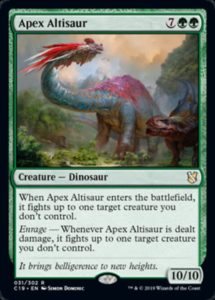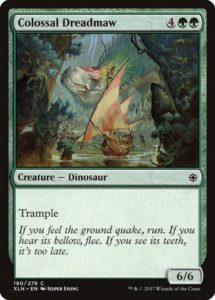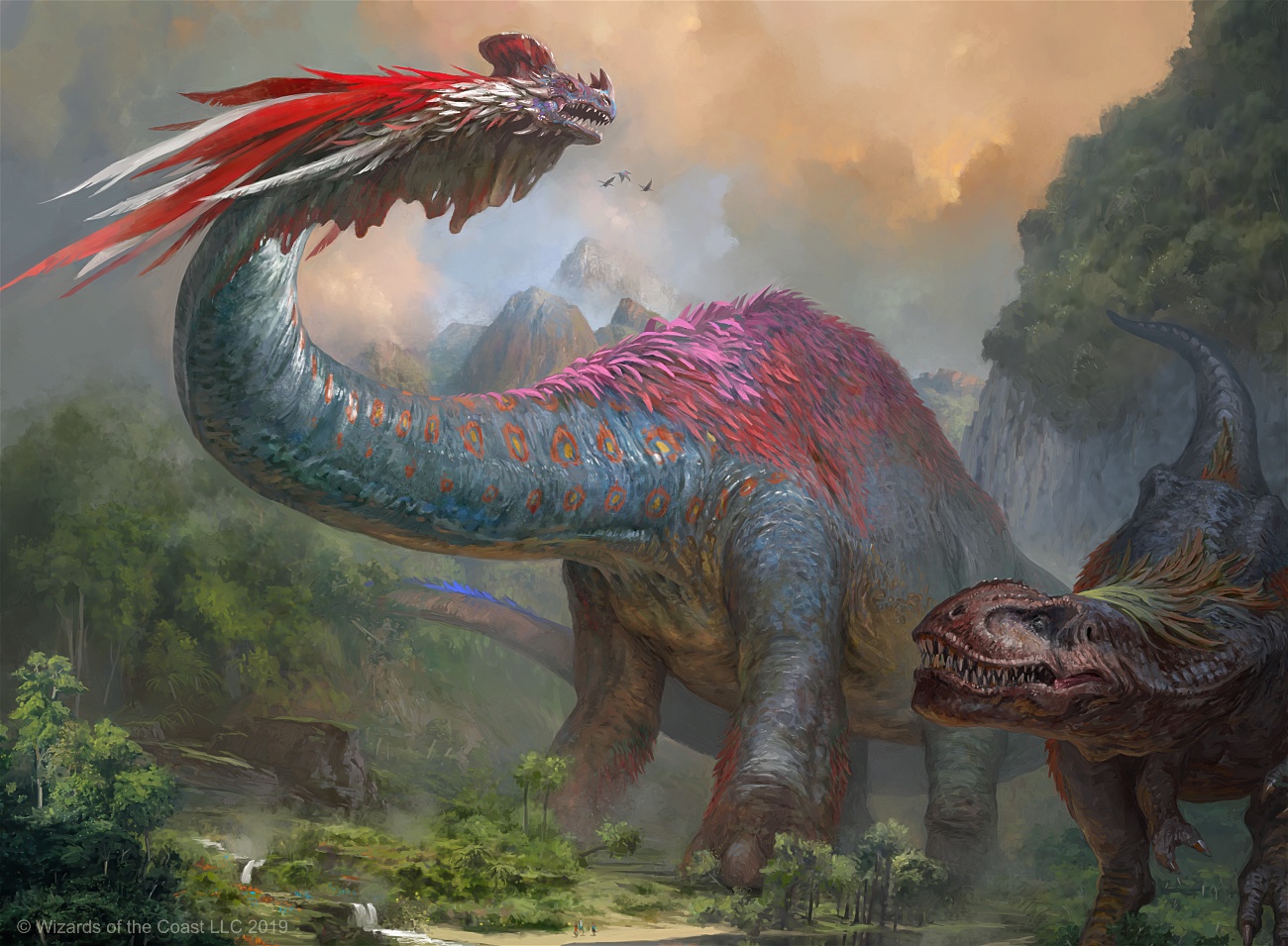In my spare time (which I never have quite enough of), I like to design new Magic cards and mechanics. It’s something I’ve been doing on and off for the last 25 years (and yes, I still have most of my old, terrible, color pie-breaking designs). But over the last few years, there’s a design I keep coming back to and trying out: a spell to make a creature fight and fight and fight until either it dies or has nothing left on the opponent’s side to fight. Nothing ever came out quite cleanly enough and I haven’t a swing at it for a while. Heck, I’d forgotten about this particular pet project that was original inspired by Time to Feed. And then this happened…
Apex Altisaur from Commander 2019 is beautiful. It’s so clean. It benefits from the new technology of Enrage, and because the ETB and Enrage abilities are essentially identical, it’s so easy to grok what this card does. The fact that it’s a 10/10 means you actually get to do quite a lot of fighting with this thing, and the fact that it’s a nine-drop probably doesn’t matter all too much in multiplayer Commander. Sure, I’d rather this be a six mana 7/7 so I could put it in my cube, but it was designed for Commander, not Cube.
This is a pretty clean design despite it having six lines of text. It would be nice if the effect could all be on three lines “When Apex Altisaur enters the battlefield or is dealt damage, it fights…” but then it can’t have an Enrage ability and piggyback on that prior knowledge. Without that ability word (Enrage), it’s easy to miss that second trigger condition (which is something no opponent wants to walk into) and you are technically squeezing two different abilities into one. This tradeoff in favor of aesthetics would probably not be worth the cost to how it plays and so it was designed thusly.
The final note I have on its mechanical design is that both of its fight abilities are mays, not musts. This change makes the card appreciably more powerful, since you can ensure it never fights too much at once and never fights a deathtouch creature. This does come at a cost, however, since it involves more clicks—this is a big consideration for Standard-legal cards, but this won’t be legal on Arena.
There are a bunch of little choices baked into the design of this relatively simple card and a good game designer will investigate before declaring that they’d do it differently. It isn’t wrong to want this (or any) card to be a little different. This card could have a different creature type (even though Enrage is strongly associated with dinosaurs), or the two abilities could be combined into one, but it’s worth considering the intention with which Magic’s game designers designed this. And now, we’ve hit the part where I do have a point of criticism.
Colossal Dreadmaw is a meme-y Magic card because it was almost printed four times in five sets. However, for such a simple design, its art does a great job of communicating how massive and dangerous a dinosaur can be. Dinosaurs are large and majestic, but this one is friggin’ scary.
Compare this with Apex Altisaur. We’ve seen two previous Altisaurs: Looming Altisaur (a massive but hardly threatening creature) and Temple Altisaur (a visually small and mechanically defensive creature). From what little we know of altisaurs and what we can glean of their names, they are large, long-necked, and less aggressive dinosaurs. Why then, is Apex Altisaur an altisaur and not a dreadmaw or some other twist on a T-Rex? The design of the creature is a ravenous, massive dinosaur constantly itching for a fight, but the artwork is of a very, very big thing. I couldn’t tell whether it was maybe chewing on another dinosaur, so I went to Simon Dominic’s site and found a large version of the artwork:
Nope, it’s not chewing on anything. Those little things by its mouth aren’t chunks of meat or rage-spittle, they’re scale birds. I’d thought that maybe this was a reused piece of artwork, but then I noticed that that’s a Colossal Dreadmaw next to it. It’s a scale dinosaur. That’s a fun way to communicate just how massive this thing is, but it suggests that the art team knew full well what they were dealing with when they commissioned this. If so, I’m surprised they chose to make it an altisaur and then to pose it in such a way that it clearly isn’t fighting anything. Maybe it’s about to just ruin that dreadmaw’s day, but that’s a subtle thing to communicate in a tiny piece of art that also needs to communicate the two dinosaurs’ relative scale, Apex Altisaur‘s scale in relation to the environment, and the area itself while also fitting in a small area on a 3.5″ x 2.5″ card.
Yes, this is a small nitpick, but it’s the one thing that keeps me from totally loving this card. I was excited to discover such an elegant way to crack this design question I’ve had for years and how it withstood my initial criticism so easily. At the end of the day, I appreciate the art, but it being mismatched with the card’s function is the only thing I can confidently criticize. It’s always good to give designers the benefit of the doubt, and I can’t wait to see what I’ve missed in the art, design, or lore to countermand my criticism of the art. But of those three lenses, I’ve been trained most in design and least in art, so my bias is certainly to find fault there. That’s my final lesson for today: know what you’re good and not-so-good at perceiving and let that mediate your judgments.
And, as always, thanks for reading.
—Zachary Barash is a New York City-based game designer and the commissioner of Team Draft League. He designs for Kingdom Death: Monster, has a Game Design MFA from the NYU Game Center, and does freelance game design. When the stars align, he streams Magic (but the stars align way less often than he’d like).
His favorite card of the month is Ill-Gotten Inheritance. It’s not often that you can staple two generally bad effects together and get something powerful, but this unassuming enchantment managed to create an exciting whole out of underwhelming parts. Moreover, it subtly engaged with two very different guilds’ themes while enabling both aggressive and defensive strategies. That’s a lot of work for a pretty straightforward common.




